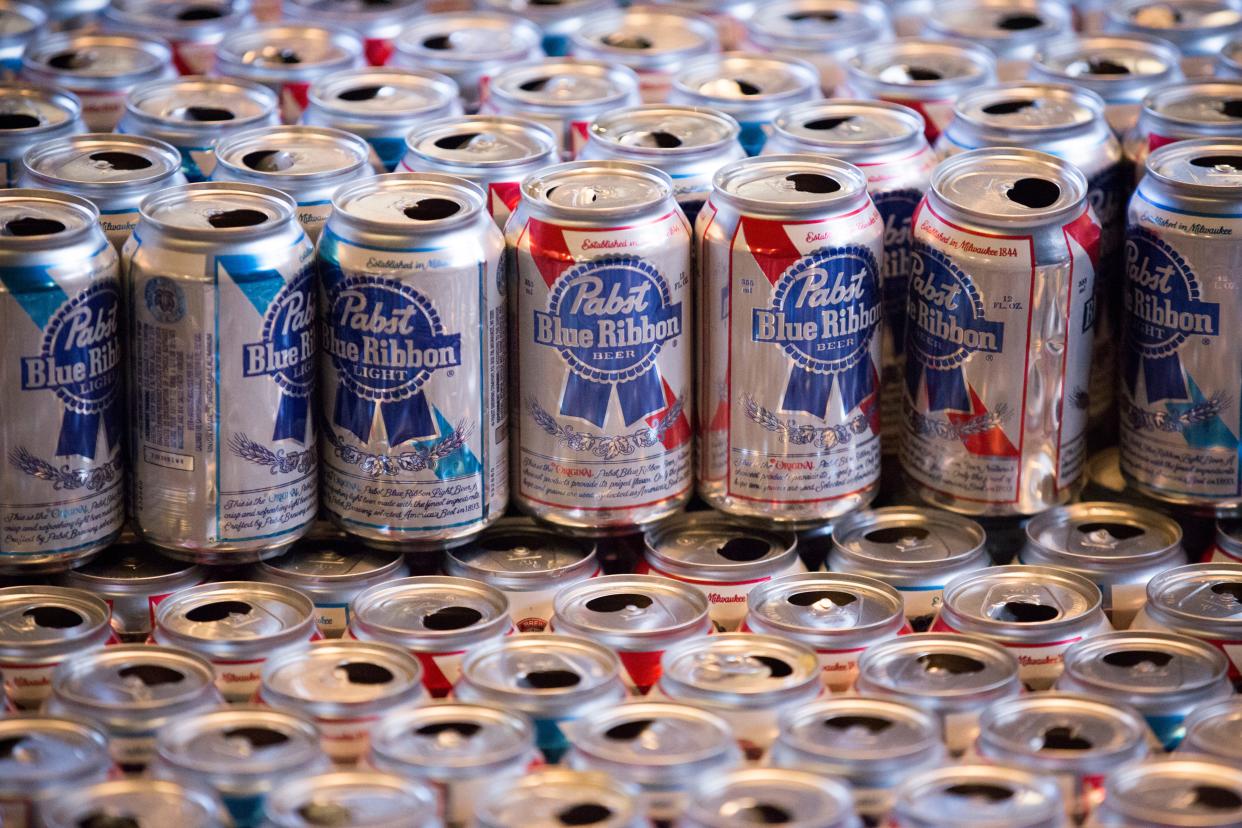Pabst Blue Ribbon: Longevity, spikes in popularity prove it's not just a 'hipster' fad

- Oops!Something went wrong.Please try again later.
"Looks like cheap beer. ... Smells like beer. ... It's cheap and tastes like beer."
"tastes like soaking wonderbread in carbonated water."
"look, nobody is coming to a PBR expecting to drink a life-changing beer. its a joy just to share some cheap fizzy hops drink with your buddies, making some memories."
So say the crowd-sourced reviews on Beer Advocate about Pabst Blue Ribbon, a standard, pale-yellow American lager with a 4.8% alcohol by volume, but one whose colorful history stretches back some 178 years and includes being serenaded in song (Johnny Russell's 1973 country hit "Rednecks, White Socks and Blue Ribbon Beer"), and winning some best beer awards.
Breaking barriers: Crafted Culture Brewing breaks barriers as the first Black-owned brewery in central Ohio
Yep, you read that last part correctly: In 1882, Pabst Blue Ribbon — then called Best Select — added blue ribbons around its bottle necks after receiving top awards at U.S. and international competitions, hinting at the name change into an iconic brand that would eventually follow.
Through the years, PBR saw eras of soaring success and steep drops in popularity, before rocketing back into the zeitgeist thanks to the 20-something hipster crowd of the 2000s, which latched onto to its retro, non-mainstream feel and acceptable drinkability at a cheap price.
But after its founding in the mid-1800s and change to the Pabst name in 1889, brewing under Pabst family ownership has been relegated to a quaint thing of the past.
"Really, the way to think about (PBR today) is more as a beer marketing company," Ohio State University economics professor Matthew Weinberg told NPR's Marketplace.
Since 2014, the Pabst Brewing Company and the Blue Ribbon brand name has been owned by Blue Ribbon Partners, led by American beer entrepreneur Eugene Kashper and TSG Consumer Partners, which bills itself as "a leading strategic equity firm focused exclusively on the branded consumer sector," which sounds very corporate and not at all hip or non-mainstream.
Beer review: Oh You, Oh Yeah stout collab an excellent ode to brewers' college days of yore
The current Pabst portfolio does include other old-school brews such as Schlitz, Stroh's, Old Milwaukee, Colt 45, Schaefer, Old Style, Lone Star, Rainier and Ballantine, the brands that dads drank while sitting around in folding chairs in the garage the 1970s and kids amassed when beer can collecting was all the rage in that era.
As for actual PBR, it is now brewed by conglomerate Molson Coors — to be transferred to City Brewing in LaCrosse, Wisconsin, by 2024 — through contractual agreement. PBR's other legacy brands also are brewed by third parties.
That's a far cry from when Jacob Best founded the Best and Company brewery in Milwaukee as a tiny operation in 1844, and began making the beer that would eventually become PBR.
Frederick Pabst — commonly known as Captain Pabst — married into the Best family in 1859 and became a partner in the brewery in 1863. With Captain Pabst serving as company president, by 1872 Best was producing 100,000 barrels a year and had become the nation's second-largest brewer.
In 1889, Best and Company changed its name to Pabst Brewing Company. Six years later, Best Select was officially renamed Pabst Blue Ribbon, and the diagonal red stripe was added to the iconic blue-ribbon label.
Up for debate is who actually invented the now-standard six-pack — some say it was Pabst, which began selling canned beer in 1935, while others credit Anheuser-Busch or other brewers, or Coca-Cola, which might have pioneered the concept in the 1920s.
During Prohibition, Pabst even added a cheese-making operation, which eventually was bought out by Kraft.
Ownership changes followed in 1984 and 2010 as the company passed from the Pabst family. Its flagship brewery in Milwaukee closed in 1996.
In 1999, Pabst acquired Detroit's Stroh Brewing Company, but by that time sales of PBR were in a precipitous nosedive, declining by 90% from their heyday in 1975 to 2001, when they fell to fewer than 1 million barrels, according to HuffPost.
Savor the flavor: Do nonalcoholic beers pass the flavor test? What to know about alcohol-free ambers, stouts and more
Hipsters, however, rode to the rescue. PBR began partnering with brands well-known to that audience, such as O'Neill surf wear and boards, Santa Cruz skateboards and Vans shoes. It also sponsored a music festival in Portland, Oregon, and various artist programs.
"(Pabst) linked themselves to a variety of things that presented the 'autonomous' image," University of Colorado marketing professor Margaret C. Campbell told HuffPost. "For example, they sponsored bike messenger rodeos, and they did it in Portland, which is a very autonomous city."
It worked. Sales jumped, hitting 90 million gallons by 2013, a 200% increase from 2004, HuffPost reported.
The brand remains relevant today, ranking among the top 20 beers in U.S. sales for 2021.
pholbrook@gannett.com
This article originally appeared on The Columbus Dispatch: Pabst Blue Ribbon ranks among top 20 beers in US sales for 2021

